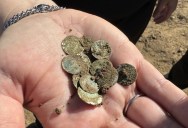900 Years After A Fortune Was Buried, A Very Lucky Woman Finds It On Her Daily Walk

Picture the scene. You’re a rich person in 12th Century Europe. You’ve got a lot of money but the political situation in the Czech Republic (then known as the Kingdom of Bohemia) is unstable.
Worried about losing your money, you bury it underground, in a spot known only to you.
Left forgotten, your fortune remains undetected through the centuries. Then, 900 years later, a woman out on her daily walk spots something in the soil.
After nine centuries, your treasure trove has finally been revealed once more.

That’s exactly what happened in Kutnohorsk, Czech Republic. The woman quickly alerted archaeologists from the Academy of Sciences of the Czech Republic, Prague.
A team of medieval experts excavated the site, finding over 2,000 coins. Once processed, archaeologists expect this to be the largest ever discovery of medieval artefacts in the region.
Though the previous owner of the coins remains unknown, it is indisputable that they were a high-ranking person in medieval society. In a press release, Filip Velímský, from the Institute of Archeology of the Academy of Sciences of the Czech Republic, explained that this amount money would be almost inconceivable, even by modern standards:
“Unfortunately, for the turn of 11.-12. century, we lack data on the purchasing power of the contemporary coin. But it was a huge amount, unimaginable for an ordinary person and at the same time unaffordable. It can be compared to winning a million in the jackpot.”
Velímský goes on to note that incredibly, the coins were buried together in one pot. However, centuries of weathering and farming of the land above it caused significant damage. Only the base of the pot was found intact:
“The entire collection was originally stored in a ceramic container, from which unfortunately only the bottom was preserved after plowing. It was probably placed there during the first quarter of the 12th century, at a time of internal political instability.”

Subsequent examination of the coins has told the researchers a lot about not only where they were made, but about coin production in medieval Czechia, too. Director of the Czech Silver Museum, Lenka Mazačová, explains that the coins were made of an alloy of silver, copper and lead. This helped the archaeologists to understand more about the discovery:
“The coins were most likely minted in the Prague mint from silver that was imported to Bohemia at the time.”
Experts are currently in the process of fully examining, cleaning, and classifying the massive haul of medieval coins. This is undoubtedly a massive operation, but the value of this find to Czech history is immense.
It is hoped that, after 900 years of waiting, the unearthed coins will be on public display at the Czech Silver Museum very soon.
If you think that’s impressive, check out this story about a “goldmine” of lithium that was found in the U.S. that could completely change the EV battery game.

Sign up to get our BEST stories of the week straight to your inbox.




